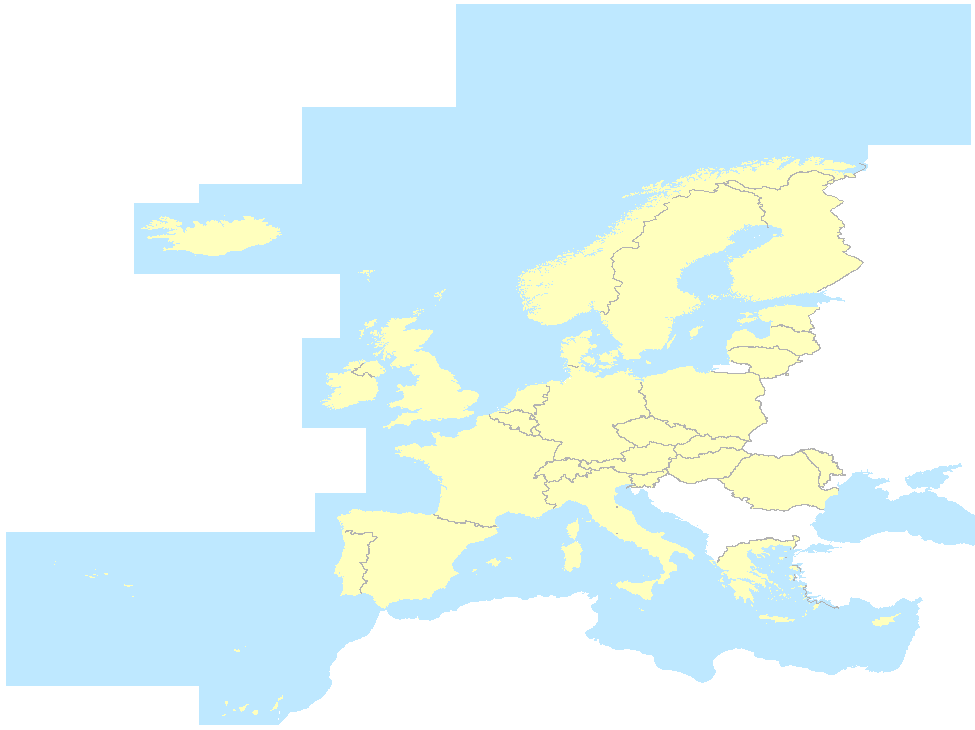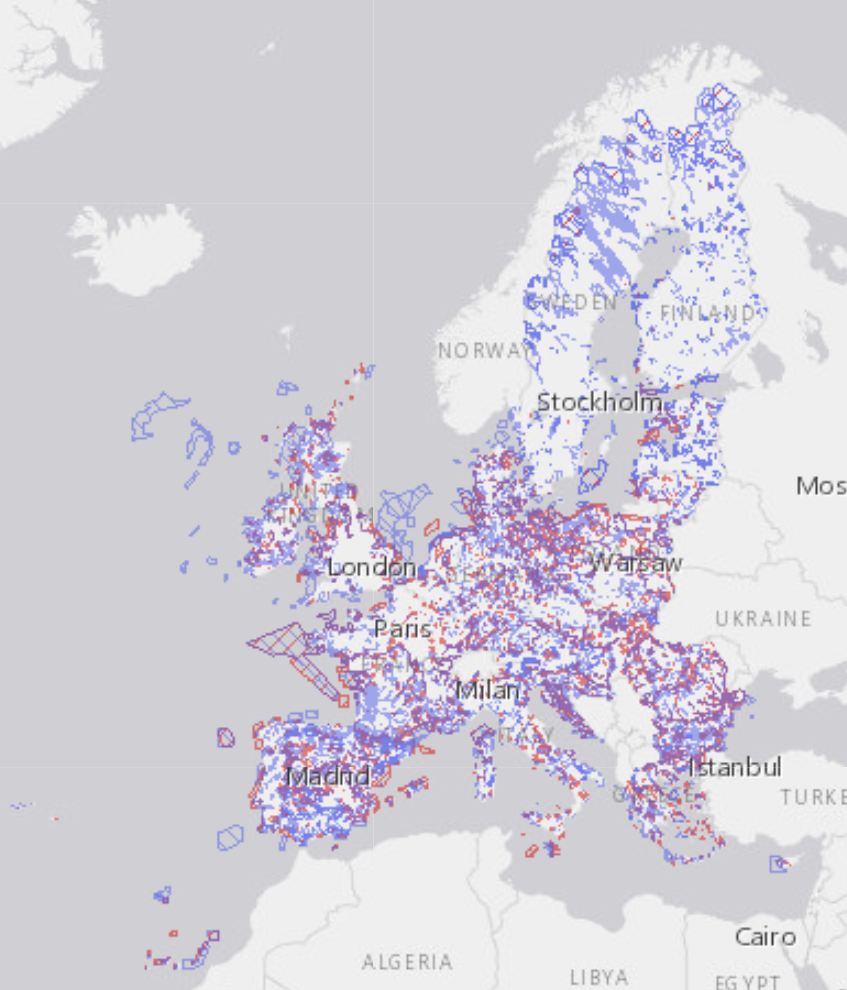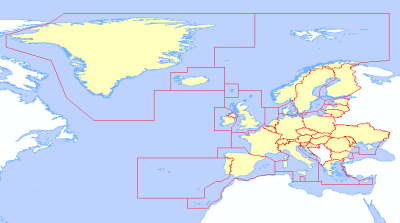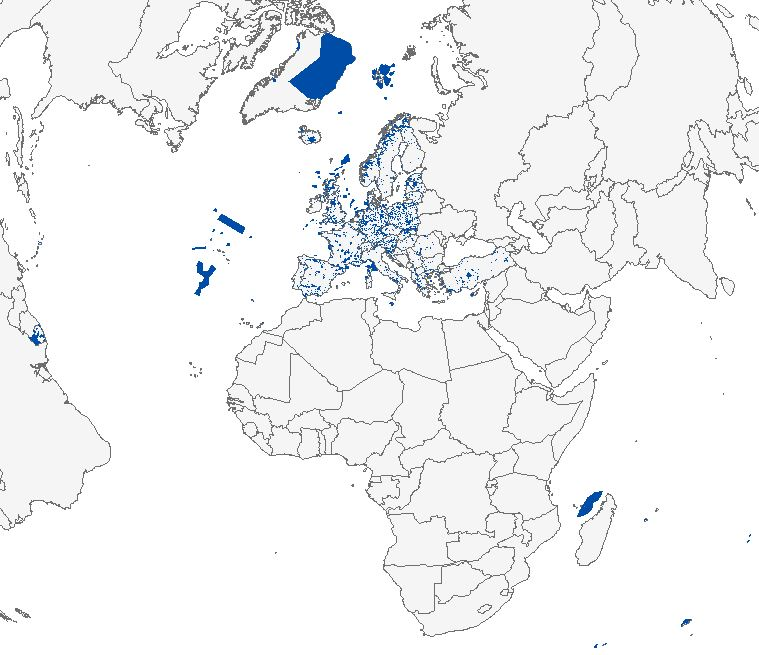annually
Type of resources
Available actions
Topics
INSPIRE themes
Keywords
Contact for the resource
Provided by
Years
Formats
Representation types
Update frequencies
status
Scale
Resolution
-

Consolidated raster containing the original CDDA polygons.
-

EuroRegionalMap v4.0 is a pan-European dataset containing topo-geographic information at the scale 1:250 000 assembled from 31 country data sets covering 26 EU Countries (Bulgaria not included), 4 EFTA countries, the Republic of Moldova. It is a seamless (there are no gaps between graphical objects initially derived from different sources) and harmonised data and is produced in cooperation by the National Mapping and Cadastral Agencies of Europe, using official national databases. Themes: a) Administrative (administrative boundaries, administrative areas) b) Hydrography (well, coastline / shoreline, foreshore, island, sea, aqueduct, lake / pond, reservoir, spring / water hole, waterfall, watercourse, dam / weir, lock, glacier, snow field / ice field, wetland) c) Transportation (railway, interchange of motorways, road, control tower, level crossing, ferry crossing, ferry station, entrance / exit, railway station, vehicle stopping area / rest area, pier / wharf / quay, airport / airfield, heliport, runway) d) Settlements (built-up area, named location) e) Soil and vegetation
-

Natura 2000 is the key instrument to protect biodiversity in the European Union. It is an ecological network of protected areas, set up to ensure the survival of Europe's most valuable species and habitats. Natura 2000 is based on the 1979 Birds Directive and the 1992 Habitats Directive. This version covers the reporting in 2019. Natura 2000 is an ecological network composed of sites designated under the Birds Directive (Special Protection Areas or SPAs) and the Habitats Directive (Sites of Community Importance or SCIs, and Special Areas of Conservation or SACs). The European database of Natura 2000 sites consists of a compilation of the data submitted by the Member States of the European Union. This European database is generally updated once a year to take into account any updating of national databases by Member States. However, the release of a new EU-wide database does not necessarily mean that a particular national dataset has recently been updated. The descriptive data in the European database are based on the information that national authorities have submitted, for each of the Natura 2000 sites, through a site-specific standard data form (SDF). In addition to other site-specific information, the standard data form provides the list of all species and habitat types for which a site is officially designated. The spatial data (outlining the boundaries of sites) submitted by each Member State are validated by the European Environment Agency (EEA). Any problems identified through the above validation procedures in the national datasets are brought to the attention of the Member States concerned. However, it remains up to the Member States to decide whether to submit a revised dataset before the European database is updated. The EEA therefore cannot guarantee that all inconsistences detected in national datasets are removed in the European dataset. Please note that some Member States have submitted sensitive information that has been filtered out of this database. The following Member States have submitted sensitive information: Austria, Belgium, Cyprus, Estonia, Finland, France, Germany, Ireland, Italy, Latvia, Lithuania, Luxembourg, Malta, Poland, Portugal, Slovakia, Spain, Sweden and United Kingdom. This concerns mainly species associated to specific sites. All reference to these species has been removed from the related sites. If this sensitive information is necessary to your field of research, please contact the Member State administrations individually. You can find a compiled list of national or regional Natura 2000 websites at the following address: http://ec.europa.eu/environment/nature/natura2000/db_gis/index_en.htm#sites There are specific terms and conditions relating to the use of downloaded boundary data within the United Kingdom. If you intend to use the UK data, you must first agree to the end-user licence http://www.jncc.gov.uk/page-5232. Besides the web service link provided in the metadata, the following services provide information on species and habitat types inside the Natura 2000 sites: https://bio.discomap.eea.europa.eu/arcgis/rest/services/ProtectedSites/Natura2000Habitats/MapServer https://bio.discomap.eea.europa.eu/arcgis/rest/services/ProtectedSites/Natura2000Species/MapServer NOTE: The dataset has been corrected in June 2020 and the files uploaded on the SDI on 30 July 2020. Files downloaded before that date has one invalid site type code (G) that was corrected (to B) in June.
-

ECDDA polygon dataset. Geographical extent covers covers Europe, Russia, Central Asia, Greenland, French DOM-TOM & COM. Polygon data of nationally designated areas.
-

Consolidated raster containing the original CDDA polygons.
-

EuroRegionalMap v4.0 is a pan-European dataset containing topo-geographic information at the scale 1:250 000 assembled from 31 country data sets covering 26 EU Countries (Bulgaria not included), 4 EFTA countries, the Republic of Moldova. It is a seamless (there are no gaps between graphical objects initially derived from different sources) and harmonised data and is produced in cooperation by the National Mapping and Cadastral Agencies of Europe, using official national databases. Themes: a) Administrative (administrative boundaries, administrative areas) b) Hydrography (well, coastline / shoreline, foreshore, island, sea, aqueduct, lake / pond, reservoir, spring / water hole, waterfall, watercourse, dam / weir, lock, glacier, snow field / ice field, wetland) c) Transportation (railway, interchange of motorways, road, control tower, level crossing, ferry crossing, ferry station, entrance / exit, railway station, vehicle stopping area / rest area, pier / wharf / quay, airport / airfield, heliport, runway) d) Settlements (built-up area, named location) e) Soil and vegetation
-

The Common Database on Designated Areas (CDDA) is more commonly known as Nationally designated areas. The inventory began in 1995 under the CORINE programme of the European Commission. It is now one of the agreed Eionet priority data flows maintained by EEA with support from the European Topic Centre on Biological Diversity. It is a result of an annual data flow through Eionet countries. The EEA publishes the data set and makes it available to the World Database of Protected Areas (WDPA). The CDDA data can also be queried online in the European Nature Information System (EUNIS). Geographical coverage of GIS vector boundary data: Albania, Austria, Belgium, Bosnia and Herzegovina, Bulgaria, Croatia, Cyprus, Czech Republic, Denmark, Estonia, Finland, Great Britain, Greece, Ireland, France, Germany, Iceland, Italy, Kosovo under UNSC Resolution 1244/99, Latvia, Liechtenstein, Lithuania, the North Macedonia, the Netherlands, Norway, Poland, Portugal, Romania, Serbia, Slovakia, Slovenia, Spain, Sweden and Switzerland. EEA does not have permission to distribute some or all sites reported by Austria, Bulgaria, Estonia, Ireland, Romania and Turkey. When re-using the data, copyright is to be mentioned specifically for Estonia and for Finland: "Estonian Environmental Register 02.03.2015"; "©Finnish Environment Institute, 2015".
-
Soil moisture deficit during the vegetation growing season, annual time-series, 2000-2019, Sep. 2020

The dataset consists of a collection of annual soil moisture (SM) anomalies during the vegetation growing season (GS) for the years 2000-2019 across EEA 38 area and the United Kingdom. The vegetation growing season is defined by EEA´s phenology data series "Vegetation growing season length 2000-2016", available in the EEA website and in this catalogue. The anomalies are calculated based on the European Commission's Joint Research Centre European Drought Observatory (EDO) Soil Moisture Index (SMI) with respect to the 1995–2019 base period. The yearly start and end of GS periods are dynamic and calculated according to the EEA Phenology Indicators. A positive anomaly indicates that the observed SM was wetter than the long-term SM average for the base period, while a negative anomaly indicates that the observed SM was drier than the reference value. Because SM anomalies are measured in units of standard deviation from the long-term SMI average, they can be used to compare annual deficits/surplus of SM between geographic regions. EDO is one of the early warning and monitoring systems of the Copernicus Emergency Management Service. As the dataset builds on EDO's SMI, it therefore contains modified Copernicus Emergency Management Service information (2019).
-

The Common Database on Designated Areas (CDDA) is more commonly known as Nationally designated areas. It is the official source of protected area information from European countries to the World Database of Protected Areas (WDPA). The inventory began in 1995 under the CORINE programme of the European Commission. It is now one of the agreed Eionet priority data flows maintained by EEA with support from the European Topic Centre on Biological Diversity. The CDDA data can be queried online in the European Nature Information System (EUNIS). Geographical coverage of GIS vector boundary data: Albania, Austria, Belgium, Bosnia and Herzegovina, Bulgaria, Croatia, Cyprus, Czech Republic, Denmark, Estonia, Finland, France, Germany, Greece, Hungary, Iceland, Ireland, Italy, Kosovo under UNSC Resolution 1244/99, Latvia, Liechtenstein, Lithuania, Luxembourg, the North Macedonia, Malta, Montenegro, the Netherlands, Norway, Poland, Portugal, Romania, Serbia, Slovakia, Slovenia, Spain, Sweden, Switzerland and United Kingdom. EEA does not have permission to distribute some or all sites reported by Estonia, Ireland, Romania and Turkey. When re-using the data, copyright is to be mentioned specifically for Estonia and for Finland: "Estonian Environmental Register 01.01.2017; "©Finnish Environment Institute, 2017".
-

The Common Database on Designated Areas (CDDA) is more commonly known as Nationally designated areas. It is the official source of protected area information from European countries to the World Database of Protected Areas (WDPA). The inventory began in 1995 under the CORINE programme of the European Commission. It is now one of the agreed Eionet priority data flows maintained by EEA with support from the European Topic Centre on Biological Diversity. The CDDA data can be queried online in the European Nature Information System (EUNIS). Geographical coverage of GIS vector boundary data: Albania, Austria, Belgium, Bosnia and Herzegovina, Bulgaria, Croatia, Cyprus, Czech Republic, Denmark, Estonia, Finland, France, Germany, Greece, Hungary, Iceland, Ireland, Italy, Kosovo under UNSC Resolution 1244/99, Latvia, Liechtenstein, Lithuania, Luxembourg, the North Macedonia, Malta, Montenegro, the Netherlands, Norway, Poland, Portugal, Romania, Serbia, Slovakia, Slovenia, Spain, Sweden, Switzerland, Turkey and United Kingdom. EEA does not have permission to distribute some or all sites reported by Austria, Estonia, Hungary, Ireland, Romania and Turkey. When re-using the data, copyright is to be mentioned specifically for Estonia and for Finland: "Estonian Environmental Register 01.01.2016; "©Finnish Environment Institute, 2016".
 RUC Geo-Data catalogue
RUC Geo-Data catalogue